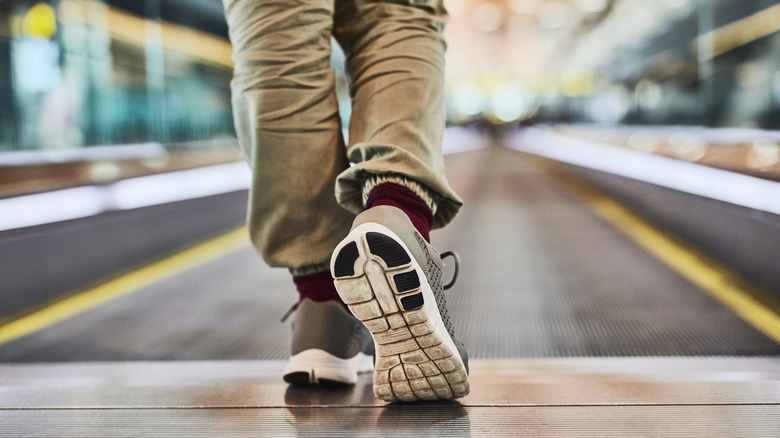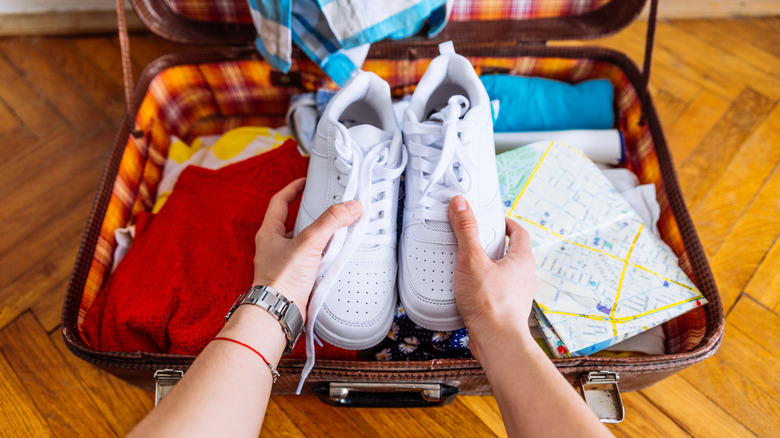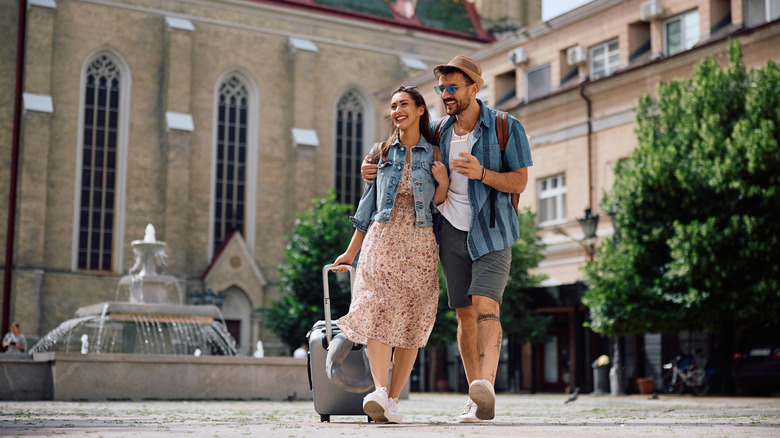A Footwear Travel Hack Taken From Runners Keeps Your Feet Fresh For Long Days Of Sightseeing
From packing up all your toiletries to choosing which clothes and accessories will help you look best while traveling, packing for vacation involves making a lot of decisions. That said, things get a little more complicated when it comes to footwear. Many travelers make the all-too-common packing mistake of bringing just one pair of shoes to try and save luggage space. However, after a few days of continuous wear, those "comfortable shoes" you planned to rely on can quickly turn into your worst enemy, giving you painful blisters, sore arches, and general foot fatigue.
The thing is, what most casual travelers don't realize is that, similarly to running enthusiasts, there's a simple strategy that can help them avoid discomfort: rotating between multiple pairs of shoes. Most runners typically alternate between two pairs of shoes depending on the intensity of their workout, which ultimately allows the cushioning materials in each pair to fully recover before getting worked again. This same principle applies to travel shoes, where daily sightseeing often means spending more time on your feet than you would during a normal day at home or at work. The constant compression can break down even the most supportive shoes quickly, and your feet suddenly lose the protection they need.
So, what's the solution? It's easy: Bring another pair of shoes to alternate what you wear each day of the trip. By doing so, you won't just extend the life of your favorite walking shoes — you'll also improve your comfort level throughout your entire trip. Because, at the end of the day, getting rid of a shirt or two to make room for an extra pair of shoes will be a worthwhile compromise when you're clocking in 20,000-plus steps a day.
Why rotating your shoes is good for your feet
The most important thing to keep in mind when rotating your shoes is design. For starters, in terms of mechanics, different shoes engage different muscle groups in your feet and legs. That way, when you alternate between shoes with slightly different support structures, heel drops, or arch support, you prevent overworking the same muscles day after day. This balanced approach ultimately helps reduce fatigue and soreness — especially if you're walking more than usual.
Additionally, many travelers also experience foot swelling during extended trips, especially when flying or if they're spending long periods of time standing up. This might mean that the shoe that felt perfect in the morning might feel constrictive by evening, making the second pair a welcome relief the next day. Plus, alternating between two pairs with slightly different fits also gives your feet flexibility as they naturally expand and contract throughout your trip.
Finally, temperature regulation is another hidden benefit of shoe rotation. Research shows that feet can produce up to a half cup of sweat every day — even without exercise. With that in mind, having a fresh pair available will keep your feet smelling fresh during a long day of sightseeing while the previously worn pair has time to fully air out. This also significantly reduces your risk of developing any fungal infections, which thrive in the warm, damp environment of continuously worn shoes.
Choosing the right shoes for your trip
When it comes to choosing which two pairs of shoes to bring on your trip, think about versatility. A good combination can include one pair of casual sneakers and one more athletic option. That way, the casual sneakers can work well with dresses, slacks, or jeans for city exploration, while the athletic sneakers are ideal for days when your itinerary includes extensive walking or hiking.
Alternatively, you can also consider pairing comfortable sneakers with supportive sandals for warm-weather destinations. This combination will give you breathable options for different temperatures and activities while still providing the rotation your feet need. Oh, and save yourself the hassle and leave the heels at home! Unless you're planning on attending a formal event, flat sandals will do just the trick on nights out.
Along with style, pay attention to the materials as well. Breathable fabrics like mesh allow better airflow, which is especially important in warm destinations. For cooler or wet climates, water-resistant materials might be more practical. Beyond that, the best travel shoes also tend to be lightweight and flexible enough to pack easily. In cases like this, slip-on styles can be particularly convenient for airport security and quick transitions — just make sure they can still provide adequate support for long walking days.


